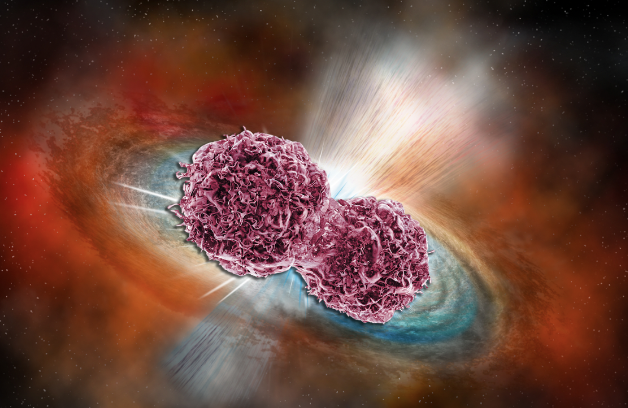
Mapping Stars and Cells: How Astronomy has Advanced Cancer Detection
By MJ Smith
Cancer victimizes 13% of biological women at some point in their lives, often inflicting significant emotional hardships and healthcare discrimination. For decades, medicinal technology such as breast cancer detection has been paramount for observational technology brought by other disciplines, especially aerospace and astrophysics, expanding their influence beyond the cosmos. Radiation, a byproduct of atomic processes in both our small-scale and large-scale universe, travels through space at different frequencies—, ranging from long, radio lengths to short, gamma lengths. Naturally emitted from stars and cells alike, this radiated energy is critical to how we interpret the universe around us. Specifically, detectors at large frequencies are adept at observing and imaging a large scale of small things. Half of the process involves pinpointing infinitesimally small objects at specific coordinates in astronomically vast planes, and the other half is imaging it using sky-mapping algorithms.
The overlap of medical and space technologies necessitates low-light sensitivity and high-quality imagery in order to locate very specific cells or stars. These specifications produce detailed photos across short time durations, which is made possible by detectors at low frequencies to contrast against background stars or cells. One of the earliest examples of astronomy cancer imaging is through a biopsy method called stereotactic fine-needle biopsies, in which a digital spot mammography method uses CCD images developed by NASA for the Hubble Space Telescope (HST) to image breast cancer cells. Used in conjunction is the image processing algorithm of the HST, a technology used to execute biopsies in breast tissue. Usually utilized for mammography, specific patterns and clusters of breast cancer indicators are filtered in the same way the HST collects data on particular stars in a supermassive cluster. These biopsies are also performed for brain, lung, and liver cancers.
The purpose of stereotactic fine-needle biopsies is to replace surgical biopsy procedures and more broadly serve the affected community. First, the imaging method of the stereotactic fine-needle biopsies accelerates the time for cancerous mutation identification and is more favorable in terms of healthcare cost and recovery. Because the technology is minimally invasive and uses radiation at larger, less energetic wavelengths, patients are subjected to approximately 50% less radiation than with surgical biopsy treatment, and an even greater percent decrease in costs.
In addition to stereotactic fine-needle biopsies, a project run by Johns Hopkins University, entitled AstroPath, uses a similar technology called immunofluorescent imaging to produce 2D models of terminal tumors in its microenvironment, with the purpose of identifying treatment plans. They are able to model not just the tumor itself, but also how the cancer affects the surrounding cellular neighborhood. AstroPath identifies the chemical signaling between cells to determine the way the cancer is spreading or digressing. The project also uses fluorescent-tagged antibodies to observe how the cancer is affecting the immune system, thus determining how the cancer is interacting with the body and where it will likely grow.
Astrophysics’ relevance to humanity is often overlooked, but it offers itself as a catalyst for new healthcare techniques. NASA/JPL, Johns Hopkins University, the Smithsonian Center for Astrophysics, and other world leaders in astrophysics are at the forefront of developing healthcare technology. Additionally, one of the most significant projects of modern radio astronomy is finding habitable planets outside of the solar system, none of which have been found, but discovering exo-life would alter the course of human history in a matter nearly unmatched.
References
- “Breast Cancer Statistics: How Common Is Breast Cancer?” Edited by Rick Alteri and Mamta Kalidas, How Common Is Breast Cancer, American Cancer Society, 12 Jan. 2022, https://www.cancer.org/cancer/breast-cancer/about/how-common-is-breast-cancer.html#:~:text=The%20American%20Cancer%20Society’s%20estimates,will%20die%20from%20breast%20cancer.
- Winfield, D.L., Aerospace Technology Transfer to Breast Cancer Imaging, Acta Astronautica 41:515-523, 1997.
- Hughes , S. “Opportunities for the Transfer of Astronomical Technology to Medicine*.” Springer, 2007, https://link.springer.com/.
- Berry, Sneha. “Analysis of Multispectral Imaging with the AstroPath Platform Informs Efficacy of PD-1 Blockade.” Science, 11 June 2021, https://www.science.org/doi/10.1126/science.aba2609.
- “Astropath.” The Institute for Data Intensive Engineering and Science, 20 July 2022, https://idies.jhu.edu/astropath/.
-
Image Citations
-
- Washington University Human in Mouse (WHIM) PDX models, Envigo, https://www.envigo.com/whim-pdx-models.
- Astronomers Strike Gravitational Gold In Colliding Neutron Stars, NPR, 16 Oct. 2017, https://www.npr.org/sections/thetwo-way/2017/10/16/557557544/astronomers-strike-gravitational-gold-in-colliding-neutron-stars. Accessed 1 Oct. 2022.
